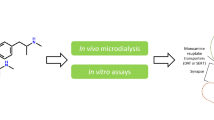Abstract
This study was designed to assess the effects of imidazoline drugs on putative presynaptic imidazoline receptors modulating brain monoamine synthesis in vivo. The accumulation of 3,4-dihydroxyphenylalanine (dopa) and 5-hydroxytryptophan (5-HTP) after decarboxylase inhibition was used as a measure of the rate of tyrosine and tryptophan hydroxylation in various brain regions of naive rats and after irreversible α2-adrenoceptor inactivation with EEDQ (1.6 mg/kg, i.p., 6 h).
Clonidine (1–3 mg/kg), moxonidine (1–10 mg/kg) and rilmenidine (10 mg/kg) (mixed I1/α2 agonists) decreased dopa and 5-HTP synthesis in the cerebral cortex (14%–81%), hippocampus (27%–84%) and/or striatum (29%–56%), but these inhibitory effects were abolished in N-ethoxycarbonyl-2-ethoxy-1,2-dihydroquinoline (EEDQ)-treated rats. Similarly, the stimulatory effect of efaroxan (mixed I1/α2 antagonist; 10 mg/kg) on dopa synthesis in the cortex (77%) and hippocampus (57%) was abolished by EEDQ. The selective I1-ligand 2-endo-amino-3-exo-isopropylbicyclo-heptane (AGN-192403; 5–10 mg/kg) did not modify dopa or 5-HTP synthesis in any brain region in naive or EEDQ-treated rats. Idazoxan (mixed I2/α2 antagonist; 20 mg/kg) increased dopa synthesis in the cortex (111%) and hippocampus (87%), but the stimulatory effects were abolished by EEDQ. Moreover, idazoxan and efaroxan decreased 5-HTP synthesis in the cortex (12%–34%) and hippocampus (30%–34%) in a manner sensitive to blockade by the 5-HT1A receptor antagonist WAY 100135. The selective I2-ligands 2-(2-benzofuranyl)-2-imidazoline (2-BFI; 20 mg/kg) and 2-styryl-2-imidazoline (LSL 61122; 10 mg/kg) did not alter the synthesis of dopa or 5-HTP in the cortex or hippocampus. In striatum, 2-BFI (1–20 mg/kg) dose-dependently decreased dopa synthesis (ED50: 5.9 mg/kg), reduced dopamine levels (6%–36%) and increased those of its metabolites DOPAC (15%–95%) and HVA (24%–74%). The inhibitory effect of 2-BFI on dopa/dopamine synthesis in striatum remained unchanged after alkylation of imidazoline receptors with isothiocyanatobenzyl imidazoline (IBI; 60 mg/kg, 6 h) or blockade of these receptors with 2-(2-ethyl 2,3-dihydro-2-benzofuranyl)-2-imidazole (KU-14R; 7–20 mg/kg).
Therefore, most imidazoline drugs modulated the synthesis of brain monoamines through interaction with α2-adrenoceptors or 5-HT1A receptors. The results do not provide functional evidence for the existence of presynaptic imidazoline receptors regulating the synthesis of monoamines in the rat brain.
Similar content being viewed by others
Author information
Authors and Affiliations
Additional information
Received: 4 January 1999 / Accepted: 12 April 1999 / Published online: 2 July 1999
Rights and permissions
About this article
Cite this article
Sastre-Coll, A., Esteban, S. & García-Sevilla, J. Effects of imidazoline receptor ligands on monoamine synthesis in the rat brain in vivo. Naunyn-Schmiedeberg's Arch Pharmacol 360, 50–62 (1999). https://doi.org/10.1007/s002109900032
Issue Date:
DOI: https://doi.org/10.1007/s002109900032




